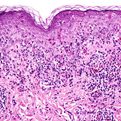Pityriasis Lichenoides Et Varioliformis Acuta
General Information
Pityriasis Lichenoides Et Varioliformis Acuta, also known as Mucha Habermann’s Disease, or PLEVA for short is a rare skin disorder characterized by an abrupt onset of red, round papules, purpura and blister like lesions. PLEVA most commonly affects the areas of the trunk, buttocks, and proximal extremities with eruptions occurring in successive crops. The lesions resolve with transient hyperpigmentation, hypopigmentation, and/or varioliform [like chickenpox] scars. PLEVA is an asymptomatic skin disorder, but pruritus with burning may occur. There is no single treatment for PLEVA, though phototherapy has been reported as useful; multiple oral medications including tetracycline, dapsone and pentoxifylline have been helpful and potent topicals can be used on lesions.
Epidemiology
Most often affects adolescents and young adults, appearing before the age of 30
Etiology
Unknown; Linked to viruses, vaccines and other illness
Pathogenesis
Appears as multiple papules that evolve into vesicles and hemorrhagic crusts
Clinical
Multiple red–to–reddish brown or purpuric round papules that are 5-15 mm in diameter.
Histology
Wedge-shaped superficial and deep dermal lymphohistiocytic infiltrate, confluent parakeratosis, thinning of the granular layer, ballooning of keratinocytes, intraepidermal vesiculation, necrosis of keratinocytes, diffuse disappearance of the dermal-epidermal junction, and dermal edema.
Bibliography
1. “Pityriasis Lichenoides” (Online). January 2007. http://www.emedicine.com/derm/TOPIC334.HTM (visited: April 1, 2008) 2. “Mucha-Habermann” (Online). http://www.glory-of-the-garden.com/plevinfo.htm (visited: April 1, 2008)
Download PDF
![]() Pityriasis Lichenoides Et Varioliformis Acuta
Pityriasis Lichenoides Et Varioliformis Acuta


